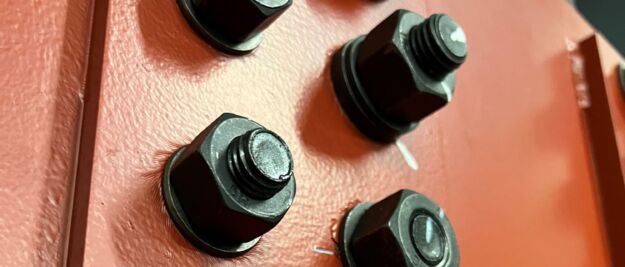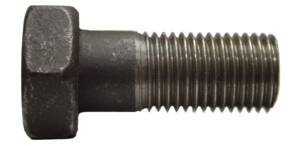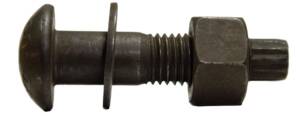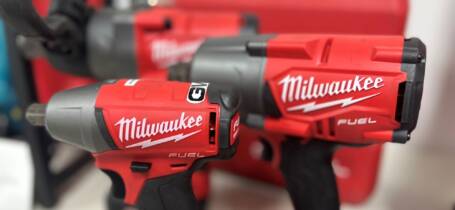
Special thanks to Bill Germuga, General Manager of St. Louis Screw & Bolt, for providing his expertise for this piece.
The Research Council on Structural Connections (RCSC) and the American Institute of Steel Construction (AISC) both provide standards and guidelines that govern industrial construction projects. Each organization also relies on ASTM standards to ensure the quality and safety of materials and methods used in applications such as bridge construction, building oil and gas systems and strengthening transportation infrastructure.
One of the most critical standards in these types of projects is ASTM F3215, or the Standard Specification for High Strength Structural Bolts and Assemblies.
What Is ASTM F3125?
ASTM F3125 is a comprehensive specification that governs high-strength structural bolts used in construction applications.
The specification was developed by the American Society for Testing and Materials (ASTM) to merge and expand upon six previous specifications (A325, A325M, A490, A490M, F1852 and F2280). By consolidating these specifications, ASTM F3125 aims to standardize requirements, remove redundancies and provide clearer guidelines for the manufacturing, testing and application of structural bolts across various industries.
ASTM F3125 is most applicable in structural engineering and construction contexts where high-strength fasteners are required to join structural components together securely, such as in skyscrapers or bridges. Other common use cases for ASTM F3125 include industrial facilities, the oil and gas sector and transportation systems (e.g. railroads and highways).
ASTM F3125 Bolt Types
Structural bolts within ASTM F3125 are classified into two main strength grades: 120 KSI and 150 KSI. Each grade corresponds to the traditional A325 and A490 classifications, respectively.
ASTM F3125 governs the following types of structural fastener components:
Heavy Hex Bolts
Heavy hex bolts are characterized by their larger and thicker heads compared to standard hex bolts. The “heavier” head dimensions provide a greater bearing surface and increased strength. These bolts are commonly used in construction and structural applications where high strength is required.
Twist-Off (Tension Control or TC) Bolts
Twist-off bolts, also known as tension control (TC) bolts, are designed to achieve a precise tension during installation. They have a built-in mechanism where a splined end breaks off at a predetermined torque, ensuring the bolt is tightened to the correct tension. This system simplifies the installation process and provides a visual indication that the bolt has been properly tightened. Like heavy hex bolts, TC bolts are commonly used in high-strength applications, such as steel frame constructions, to ensure consistent and reliable clamping force.
Type 1 Bolts
Type 1 bolts under ASTM F3125 are general-purpose structural bolts that can come with various finishes, including plain (uncoated), mechanically galvanized or hot-dip galvanized. These bolts are suitable for a wide range of environments and applications. They are made from standard carbon steel and are available in both 120 KSI and 150 KSI strength grades. The versatility in their finish options allows engineers to choose the most appropriate bolt for their specific environmental conditions and project requirements.
Type 3 Bolts
Type 3 bolts are made from weathering steel, which offers greater corrosion resistance compared to standard carbon steel. The weathering steel composition allows these bolts to form a protective rust layer when exposed to the elements, preventing further corrosion. This makes Type 3 bolts particularly suitable for outdoor applications and structures exposed to harsh weather conditions. Like Type 1 bolts, Type 3 bolts are available in both 120 KSI and 150 KSI strength grades.
Where Did ASTM F3125 Come From?
ASTM F3125 represents a merging of six previously separate standards: A325, A325M, A490, A490M, F1852 and F2280. Each standard only covered certain types of bolts and had limitations in terms of materials and applications.
The development of ASTM F3125 clears up prior inconsistencies and represents a more comprehensive and inclusive set of standards for structural fasteners. This broader scope means that the standard can cover a wider range of applications and materials, accommodate advancements in technology and engineering practices, and streamline global communications within the construction industry.
ASTM F3125 Updates
A notable update in ASTM F3125 is the uniform strength requirement across different bolt diameters. Previously, larger diameter bolts had lower strength requirements but now bolts from 1/2 inch to 1-1/2 inches in diameter must all meet the same strength criteria of 120 KSI or 150 KSI. This change ensures consistent performance regardless of bolt size.
The standard also introduces new marking designations to help identify specific characteristics of the bolts. For instance, bolts with special thread lengths that deviate from the ASME B18.2.6 standard are marked with an “S” designation. This allows designers to specify bolts with alternative thread lengths to meet particular design needs, such as keeping threads out of shear planes in slip-critical connections. Additionally, provisions for full-thread bolts are included, marked with a “T” designation, which allows for greater flexibility in certain applications. However, there are limits on the length of fully threaded bolts to maintain ductility and prevent excessive stretch under tension.
ASTM F3125 also introduced several new features that were not included in any of the previous six standards it replaced. These new features include:
- Inclusion of Twist-off-style / Tension Control (TC) Structural Bolts: ASTM F3125 expanded the scope to include twist-off-type tension control structural bolts, providing specifications for these specialized fasteners used in structural applications.
- Comprehensive Grading System: Unlike the previous standards, ASTM F3125 incorporates a graded system that categorizes fasteners into different grades based on their mechanical properties and performance requirements. This allows for more precise selection of fasteners for specific applications.
- Updated Testing and Quality Control Procedures: ASTM F3125 includes updated testing and quality control procedures to reflect advancements in testing methodologies and industry best practices. These rigorous testing protocols help ensure the reliability and consistency of fasteners.
- Expansion of Covered Materials: ASTM F3125 covers a broader range of materials, including carbon steel and alloy steel, to accommodate various construction requirements and advancements in material technology.
These new features represent advancements in bolting standards, providing a more comprehensive and versatile framework for structural fasteners.
ASTM F3125 Charts
F3125 Bolt Types
| Grade | Min Strength, Tensile | Type | Style |
| A325 | 120 ksi min | 1 or 3 | Heavy Hex Head |
| A325M | 830MPa min | 1 or 3 | Heavy Hex Head |
| F1852 | 120 ksi min | 1 or 3 | Twist-Off/TC |
| A490 | 150 ksi | 1 or 3 | Heavy Hex Head |
| A490M | 1040MPa | 1 or 3 | Heavy Hex Head |
| F2280 | 150 ksi | 1 or 3 | Twist-Off/TC |
|
Type 1 – 120 ksi – carbon, carbon boron, alloy, or alloy boron steel Type 1 – 150 ksi – alloy or alloy boron steel Type 3 – weathering steel |
|||
Chemical Requirements – Type 1
| Heat Analysis | 120 ksi, % | 150 ksi, % |
| Carbon | 0.30 – 0.52 | 0.30 – 0.48* |
| Manganese | 0.60 min | 0.60 min |
| Phosphorus | 0.035 max | 0.035 max |
| Sulfur | 0.040 max | 0.040 max |
| Silicon | 0.15 – 0.30 | – |
| Boron | 0.003 max | 0.003 max |
| Copper | – | – |
| Nickel | – | – |
| Chromium | – | – |
| Molybdenum | – | – |
| *Carbon 0.35-0.53% for 1-1/2” A490/150 ksi bolts | ||
Type 3 bolts can also be produced from a material with a chemical composition that has a corrosion index of 6 or greater, as calculated from the heat analysis and as described in ASTM Guide G101. The corrosion index can be calculated using the predictive method based on the data of Larrabee and Coburn or the predictive method based on the data of Townsend. (See ASTM Guide G101 for methods of estimating the atmospheric corrosion resistance of low alloy steels.)
Chemical Requirements – Type 3
| Heat Analysis | 120 ksi, % Comp A | 120 ksi, % Comp B | 120 ksi, % Index | 150 ksi, % Index |
| Carbon | 0.33 – 0.40 | 0.38 – 0.48 | 0.30 – 0.52 | 0.30 – 0.53 |
| Manganese | 0.90 – 1.20 | 0.70 – 0.90 | 0.60 min | 0.60 min |
| Phosphorus | 0.035 max | 0.035 max | 0.035 max | 0.035 max |
| Sulfur | 0.040 max | 0.040 max | 0.040 max | 0.040 max |
| Silicon | 0.15 – 0.30 | 0.30 – 0.50 | ||
| Copper | 0.25 – 0.45 | 0.20 – 0.40 | 0.20 – 0.60 | 0.20 – 0.60 |
| Nickel | 0.25 – 0.45 | 0.50 – 0.80 | 0.20 min* | 0.20 min* |
| Chromium | 0.45 – 0.65 | 0.50 – 0.80 | 0.20 min | 0.20 min |
| Molybdenum | 0.06 max | 0.10 min* | 0.10 min* | |
|
*Either Nickel or Molybdenum must be present in the amount specified *Corrosion Index based on ASTM Guide G101 |
||||
F3125 Mechanical Properties
| Grade | Tensile, ksi | Yield, ksi min | Elongation, % min | RA, % min |
| 120 ksi (A325/F1852) | 120 min | 92 | 14 | 35 |
| 150 ksi (A490/F2280) | 150-173 | 130 | 14 | 40 |
F3125 Marking Requirements & Matching Components
| 120 ksi, Type 1 | 120 ksi, Type 3 | 150 ksi, Type 1 | 150 ksi, Type 3 | |
| Marking | A325 | A325 | A490 | A490 |
| Nut, Plain | A563 DH | A563 DH3 | A563 DH | A563 DH3 |
| Nut, Coated | A563 DH | A563 DH3 | A563 DH | A563 DH3 |
| Washer | F436-1 | F436-3 | F436-1 | F436-3 |
|
||||
F3125 Permitted Coatings
| Bolt | F2329 Hot Dip Galvanizing | B695 Mechanical Galvanizing | F1136 Zinc/Aluminum (Geomet) | F2833 Zinc/Aluminum |
| A325 | Approved | Class 55 | Grade 3 | Grade 1 |
| F1852 | Not Approved | Class 55 | Not Approved | Not Approved |
| A490 | Not Approved | Not Approved | Grade 3 | Grade 1 |
| F2280 | Not Approved | Not Approved | Not Approved | Not Approved |
|
*Other coatings may be used on 120 ksi/A325 fasteners upon agreement between purchaser and user. Coatings on 150 ksi/A490 fasteners must be qualified by ASTM committee F16. *As of 2020, F1136, F2833 and F3019 have been withdrawn and combined into a new coating standard, F3393. |
||||
F3125 Nut Overtap Allowances
| Size | F2329 and B695, in | F1136 and F2833, in |
| ½-13 | 0.018 | 0.009 |
| 5/8-11 | 0.020 | 0.010 |
| ¾-10 | 0.020 | 0.010 |
| 7/8-9 | 0.022 | 0.011 |
| 1-8 | 0.024 | 0.012 |
| 1-1/8-7 | 0.024 | 0.012 |
| 1-1/4-7 | 0.024 | 0.012 |
| 1-3/8-6 | 0.027 | 0.014 |
| 1-1/2-6 | 0.027 | 0.014 |
|
||
ASTM F3125 Bolting Tools & Methods
The structural bolts used in any industrial construction project are only as good as the methods used to install them. In addition to fastener components, ASTM F3125 also governs the installation methods for structural bolts and fasteners, thereby dictating the best tools for various jobs.
- Turn-of-Nut Method: The turn-of-nut method involves tightening the nut by a specified number of degrees or fractions of a turn past snug tightness, achieved using a turn-of-nut wrench. ASTM F3125 specifies the requirements for turn-of-nut installation, including the minimum number of degrees or fractions of a turn required based on the bolt diameter and grade. This method helps achieve the desired preload or tension in the bolt, ensuring proper clamping force and joint integrity.
- Torque Method: The torque method involves tightening the nut to a specified torque value using a torque wrench. ASTM F3125 provides guidelines for torque installation, including the recommended torque values based on the bolt diameter, grade and lubrication condition.
- Shear Installation: This method involves using a shear wrench to apply a shear load to the bolt rather than a tensile load. ASTM F3125 ensures that structural bolts and fasteners meet the necessary strength and performance requirements for shear applications, such as in connections subjected to lateral forces or shear loads.
If you’re unsure which methods or tools to choose for an upcoming project, consult the experts at GWY. With experience in structural bolting tools that stretches back to the 1970s, we’re considered one of today’s global leaders in turn-of-nut, torque and shear wrenches. Whether you’re looking to buy, rent or repair, you’ll find what you need in our wide range of installation tools from highly rated manufacturers including Enerpac, TONE, Norbar and more.
Give us a call or send us a message today and we’d be happy to recommend the tools that will help you meet rigorous standards and get the job done right.







